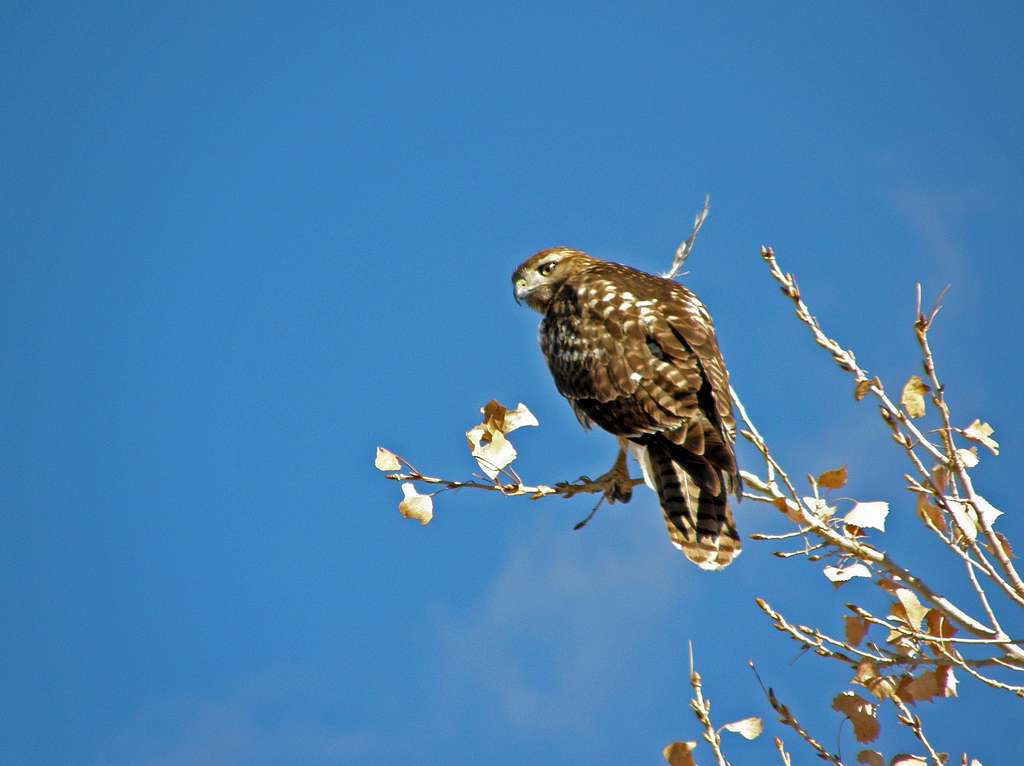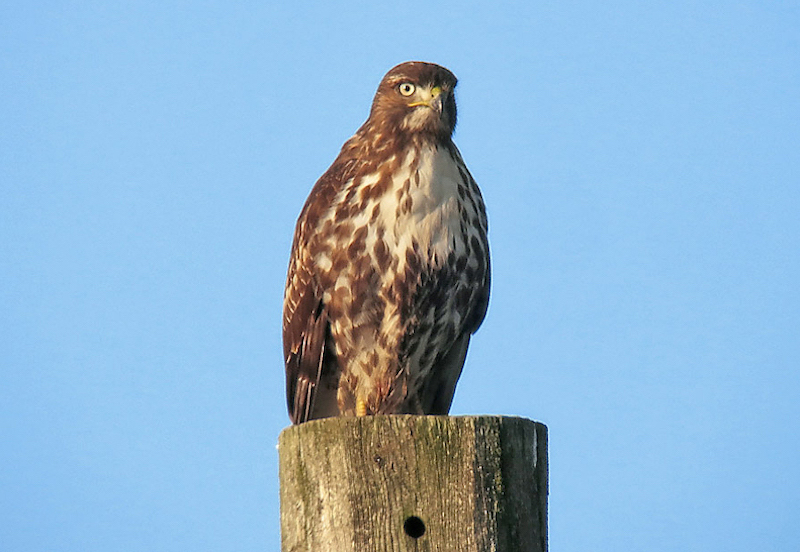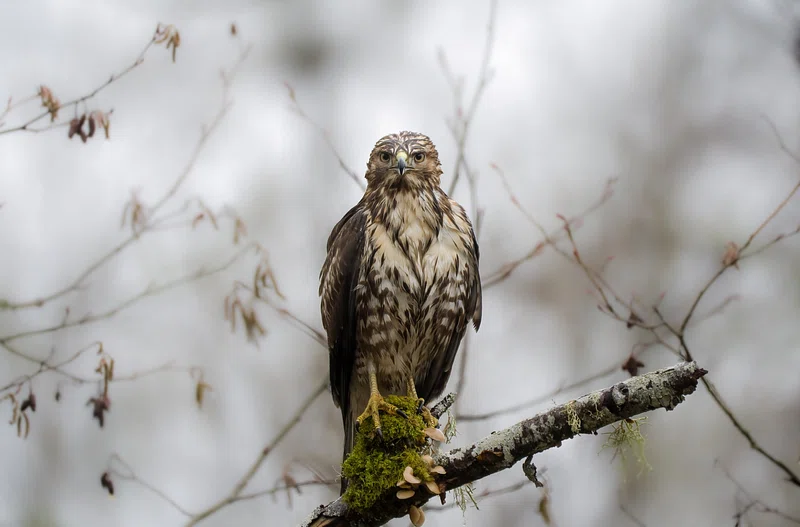Discover the majestic world of red tailed hawks. From behavior to sightings, explore their habitat and conservation. Your go-to guide for bird enthusiasts!
Introduction
The red tailed hawk, a majestic raptor soaring through North American skies, commands attention with its striking features and predatory prowess. In this introduction, we embark on a journey to unravel the allure of this iconic bird, exploring its prevalence, significance, and the importance of studying its behavior.
Overview of Red-Tailed Hawk
The red tailed hawk, scientifically known as Buteo jamaicensis, stands as one of the largest and most common birds of prey in North America. Its impressive wingspan, ranging from 3.4 to 4.8 feet, and a mass of 1.5 to 3.5 pounds, make it a formidable presence in the avian world. With keen eyesight, this hawk is a frequent companion on long car rides, gracing the skies with its distinctive red tail feathers.
Importance of Studying Red Tailed Hawks
Delving into the world of red-tailed hawks goes beyond mere fascination. Bird enthusiasts and environmentalists find profound value in understanding the behavior, habits, and adaptations of these majestic creatures. Their prevalence in diverse ecosystems makes them a vital indicator of ecological health, and studying them offers insights into broader avian dynamics.
As we explore the unique features and behaviors of the red-tailed hawk in the upcoming chapters, we invite you to join us in unraveling the mysteries of this awe-inspiring bird of prey. From its physical attributes to its cultural significance, each aspect contributes to the comprehensive tapestry of the red-tailed hawk’s existence in the natural world.
Anatomy and Characteristics
Unveiling the intricate details of the red tailed hawk’s anatomy and characteristics opens a gateway to understanding the marvels of this avian predator. As we delve into this chapter, we embark on a journey through the physical attributes, adaptations for predatory behavior, and the vast habitats these majestic birds call home.
Physical Attributes
The red tailed hawk stands as a testament to avian excellence, boasting an impressive size, wingspan, and distinctive red tail feathers.
- Size and Weight: Ranging from 1.5 to 3.5 pounds, with a wingspan spanning from 3.4 to 4.8 feet, the red tailed hawk commands attention with its robust build.
- Striking Red Tail Feathers: A hallmark feature, the red tail feathers set this species apart, catching the eye and earning its name.
Adaptations for Predatory Behavior
The red-tailed hawk’s physical features are finely tuned for efficient hunting and predatory success, making it a formidable presence in the sky.
- Speed and Diving Capabilities: With a maximum diving speed of 120 miles per hour, these hawks execute precision strikes, showcasing their aerial prowess.
Habitat and Range
Understanding the habitats where red-tailed hawks thrive provides insights into their ecological significance and the expansive territories they cover.
- Typical Habitats: Red-tailed hawks are versatile in their choice of habitats, from open country to wooded areas, showcasing adaptability.
- Extensive Range: Spanning from the icy landscapes of Alaska to the tropical reaches of Panama, their range is a testament to their adaptability.
As we unravel the physical prowess and adaptive nature of red-tailed hawks in this chapter, we pave the way for a deeper appreciation of their role in the avian kingdom.

Behavior and Lifestyle
Embarking on the enthralling exploration of the red-tailed hawk’s behavior and lifestyle unveils a captivating narrative of their dietary preferences, hunting techniques, and intricate social structures.
Diet and Hunting Techniques
The red-tailed hawk’s culinary choices are as fascinating as its aerial prowess. Delving into their diet provides a glimpse into the delicate balance they maintain in the ecosystem.
- Varied Diet: At the heart of their diet lies a preference for squirrels, showcasing their adaptability to both urban and rural landscapes.
- Precision in Hunting: The red-tailed hawk employs remarkable hunting techniques, using keen eyesight to spot prey from great heights before executing precise dives.
- Aerial Maneuvering: Their ability to soar effortlessly and execute mid-air acrobatics contributes to successful hunts, making them apex predators in their habitat.
Social Structure
Beneath the solitary elegance of the red tailed hawk lies a complex social structure that governs their interactions, mating rituals, and nesting habits.
- Solitary Predators: While predominantly solitary hunters, red-tailed hawks engage in communal activities during mating season and nesting.
- Mating Rituals: Intricate courtship displays and vocalizations mark their mating rituals, emphasizing the importance of finding compatible mates.
- Nesting Habits: These hawks exhibit a range of nesting habits, from building nests in trees to repurposing abandoned nests of other birds.
Exploring the behavior and lifestyle of red-tailed hawks not only unravels the intricacies of their survival strategies but also emphasizes their role as ecological contributors in the vast tapestry of nature.
Identification and Varieties
Dive into the intricacies of identifying the red tailed hawk and unravel the fascinating array of varieties within this majestic species.
Distinctive Features
Unlocking the secrets of identifying a red-tailed hawk involves an exploration of its unique features, a visual guide to understanding the nuances that set them apart.
- Markings and Coloration:
- Detailed examination of distinctive markings on the plumage.
- Insight into the variations in coloration that distinguish individuals.
- Size Matters:
- A comprehensive guide on how to gauge the size of red-tailed hawks.
- Explore the differences in size between males and females.
Subspecies of Red-Tailed Hawks
The red tailed hawk family extends beyond a singular species, encompassing diverse subspecies, each with its own characteristics.
- Geographical Variations:
- Explore how different regions give rise to specific subspecies.
- Highlight variations in size, plumage, and behavior among subspecies.
- Unique Characteristics:
- Dive into the distinctive features that set each subspecies apart.
- Understand the adaptations that make them well-suited to their respective habitats.
As we embark on the journey of identification, a deeper appreciation for the diversity within the red tailed hawk population emerges. Each bird is a masterpiece shaped by its environment and evolutionary path.
Red Tailed Hawk in Culture and Symbolism
Delve into the rich tapestry of cultural interpretations and symbolic significance woven around the majestic red-tailed hawk.
Symbolic Meaning
Unlock the mystique surrounding red-tailed hawks as symbols, transcending their biological existence to embody deeper meanings.
- Spiritual Significance:
- Explore how various cultures perceive red-tailed hawks as spiritual messengers.
- Discuss their role in symbolizing vision, intuition, and higher perspectives.
- Mythological Connections:
- Examine the hawk’s presence in myths and legends across different civilizations.
- Uncover stories where red-tailed hawks are revered as symbols of strength or guardianship.
Human Interaction
Navigate through the annals of history to unravel the threads of human interaction with red-tailed hawks, transcending mere encounters.
- Historical Encounters:
- Explore documented instances of red-tailed hawks in historical texts.
- Discuss their portrayal in art, literature, or folklore, shaping cultural perceptions.
- Cultural Significance Today:
- Examine how red-tailed hawks continue to influence contemporary culture.
- Highlight their presence in rituals, ceremonies, or even corporate symbolism.
As we journey into the realm of culture and symbolism, the red tailed hawk emerges not just as a biological entity but as a powerful symbol, deeply embedded in the collective consciousness of humanity.

FAQs About Red-Tailed Hawks
Explore the frequently asked questions that unravel the mysteries surrounding the captivating red-tailed hawk.
Frequently Asked Questions
1: What is the average lifespan of a red-tailed hawk?
- Red-tailed hawks typically live up to 10 to 20 years in the wild. Factors such as habitat, food availability, and human interference can influence their lifespan.
2: Do red-tailed hawks migrate?
- While some individuals migrate seasonally, many red-tailed hawks are non-migratory, adapting to the changing seasons within their established territories.
3: Can red-tailed hawks be kept as pets?
- No, it is illegal to keep red-tailed hawks as pets in most places. They are protected by wildlife laws, and capturing or keeping them without proper permits is against the law.
4: How do red-tailed hawks communicate?
- Red-tailed hawks use a variety of vocalizations to communicate. These can include high-pitched screams, whistles, and other calls used for mate communication, territorial warnings, or during hunting.
5: What is the impact of red-tailed hawks on rodent control?
- Red-tailed hawks play a crucial role in controlling rodent populations. Their preference for rodents, especially squirrels, helps maintain a balance in the ecosystem by controlling potential pest species.
6: How can I differentiate between male and female red-tailed hawks?
- Distinguishing between male and female red-tailed hawks requires attention to size and markings. Females are generally larger, with broader wings and tails, while males are smaller and more streamlined.
7: Are there any conservation concerns for red-tailed hawks?
- While red-tailed hawks are not currently listed as endangered, habitat loss and human activities pose challenges. Conservation efforts focus on preserving their natural habitats and raising awareness about the importance of these raptors in ecosystems.
Navigate the intricacies of red-tailed hawk knowledge through these frequently asked questions, shedding light on the enigmatic aspects of their existence.
script type=”application/ld+json”> { “@context”: “https://schema.org”, “@type”: “FAQPage”, “mainEntity”: [{ “@type”: “Question”, “name”: “What is the average lifespan of a red-tailed hawk?”, “acceptedAnswer”: { “@type”: “Answer”, “text”: “Red-tailed hawks typically live up to 10 to 20 years in the wild. Factors such as habitat, food availability, and human interference can influence their lifespan.” } },{ “@type”: “Question”, “name”: “Do red-tailed hawks migrate?”, “acceptedAnswer”: { “@type”: “Answer”, “text”: “While some individuals migrate seasonally, many red-tailed hawks are non-migratory, adapting to the changing seasons within their established territories.” } },{ “@type”: “Question”, “name”: “Can red-tailed hawks be kept as pets?”, “acceptedAnswer”: { “@type”: “Answer”, “text”: “No, it is illegal to keep red-tailed hawks as pets in most places. They are protected by wildlife laws, and capturing or keeping them without proper permits is against the law” } },{ “@type”: “Question”, “name”: “How do red-tailed hawks communicate?”, “acceptedAnswer”: { “@type”: “Answer”, “text”: “Red-tailed hawks use a variety of vocalizations to communicate. These can include high-pitched screams, whistles, and other calls used for mate communication, territorial warnings, or during hunting” } },{ “@type”: “Question”, “name”: “What is the impact of red-tailed hawks on rodent control?”, “acceptedAnswer”: { “@type”: “Answer”, “text”: “Red-tailed hawks play a crucial role in controlling rodent populations. Their preference for rodents, especially squirrels, helps maintain a balance in the ecosystem by controlling potential pest species.” } },{ “@type”: “Question”, “name”: “How can I differentiate between male and female red-tailed hawks?”, “acceptedAnswer”: { “@type”: “Answer”, “text”: “Distinguishing between male and female red-tailed hawks requires attention to size and markings. Females are generally larger, with broader wings and tails, while males are smaller and more streamlined.” } },{ “@type”: “Question”, “name”: “Are there any conservation concerns for red-tailed hawks?”, “acceptedAnswer”: { “@type”: “Answer”, “text”: “While red-tailed hawks are not currently listed as endangered, habitat loss and human activities pose challenges. Conservation efforts focus on preserving their natural habitats and raising awareness about the importance of these raptors in ecosystems” } }] }Conclusion
Concluding the journey through the realm of red-tailed hawks, we find ourselves immersed in the significance of these magnificent raptors and their impact on the avian ecosystem.
Summary and Key Takeaways
In summary, the red tailed hawk emerges as a symbol of power, adaptability, and ecological balance. From its physical attributes to intricate behaviors, each aspect plays a pivotal role in its survival and contribution to the natural order. The journey through this article unveils a deeper understanding of these birds of prey.
Emphasizing Ecological Importance
Red-tailed hawks, with their keen hunting prowess and role in controlling rodent populations, contribute significantly to maintaining the delicate balance of ecosystems. Their adaptability to diverse habitats, from the vast landscapes of Alaska to the tropical regions of Panama, showcases their resilience in the face of environmental challenges.
Encouraging Conservation Efforts
As we conclude, it becomes evident that preserving the habitats of red-tailed hawks is crucial for ensuring their continued existence. Conservation efforts should not only focus on protecting these raptors but also on raising awareness about their importance in the broader context of biodiversity and environmental health.
Inviting Further Exploration
While this article provides a comprehensive overview, the world of red-tailed hawks remains vast and full of nuances. Bird enthusiasts, researchers, and nature lovers are encouraged to delve deeper into the intricacies of red-tailed hawk behavior, adaptations, and their ever-fascinating interactions with the world around them.
Embark on your own exploration, armed with newfound knowledge about these remarkable birds, and contribute to the ongoing dialogue about the conservation and appreciation of the red tailed hawk.
In the grand tapestry of nature, the red tailed hawk stands as a testament to the awe-inspiring wonders that avian life brings to our world.
